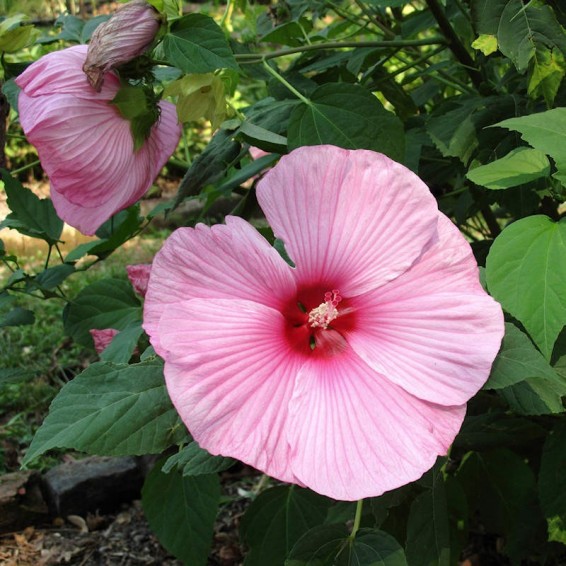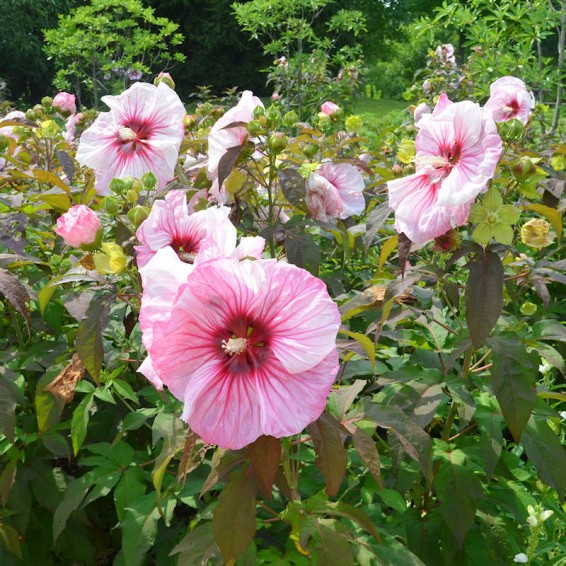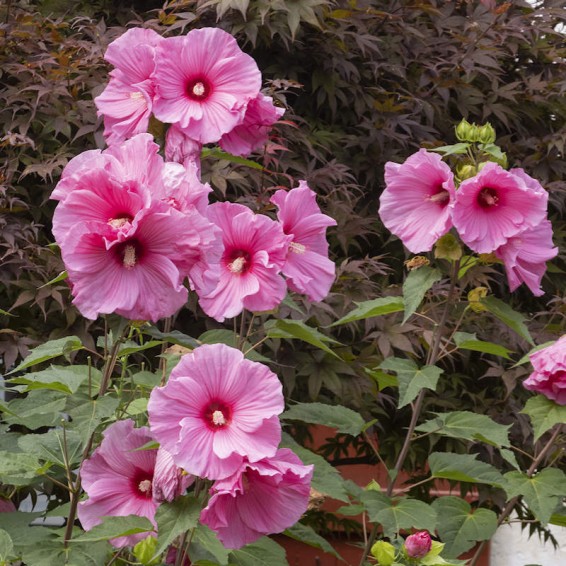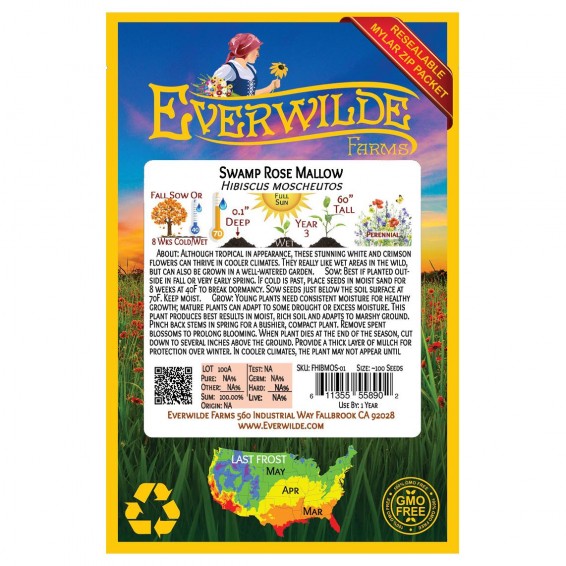Swamp Rose Mallow Seeds

- HOW TO GROW
- FAST FACTS
- REVIEWS
HOW TO GROW
Sowing: Direct sow in late fall, planting the seeds 1/4" deep. For spring planting, mix the seed with moist sand and store it in the refrigerator for 60 days before direct sowing. To start indoors, sow seeds 1/4" deep in a flat or individual peat pots, keeping the soil lightly moist and at a temperature of 80-85 degrees F until germination. Keep the seedlings evenly moist. When the weather has warmed and the seedlings are well established, transplant outdoors.
Growing: In their first seasons of development, these young plants need consistent moisture for healthy growth. Mature plants can adapt to some drought or excess moisture. In general, this plant will produce the best results in moist, rich soil and adapts well to marshy or consistently wet soil. Pinch back the growing stems in spring to produce a bushier, more compact plant. Deadhead spent blossoms to prolong blooming. When the plant dies back at the end of the season, cut it down to several inches above the ground. Provide a thick layer of mulch for protection over winter, especially if the ground freezes. In cooler climates the plant tends to be slow to emerge in the spring, often not appearing until early summer. These flowers attract bees, butterflies, and hummingbirds.
Harvesting: For fresh flowers, cut long stems of flowers that have just opened and place them in water immediately; strip the leaves that will fall below the water.
Seed Saving: After flowering, this plant will produce papery light brown seed pods that contain fuzzy, round brown seeds. Remove the pods and spread them out to dry. Open the papery pods and shake out the seed inside. Store the seed in a cool, dry place.
FAST FACTS
Common Names: Crimsoneyed Rosemallow, Marshmallow Hibiscus
Latin Name: Hibiscus moscheutos
Species Origin: US Native Wildflower
Type: Native Wildflowers
Life Cycle: Perennial
USDA Zones: 5, 6, 7, 8, 9, 10
US Regions: Mountain, Plains/Texas, Midwest, Northeast, Southeast
Seeds per Ounce: 3,600
Stratification: Cold/Wet for 8 Weeks
Germination Ease: Stratify 8 Weeks
Sunlight: Full Sun, Part Sun
Height: 60 Inches
Color: White, Pink
Bloom Season: Blooms Late Summer, Blooms Early Fall
Uses: Deer Resistant
Future rain garden
I don't have much to evaluate yet. So far the seeds are in cold stratification in my fridge for a few weeks. But the seeds arrived in a timely manner with packaging intact. Instructions on the back of the packets are detailed and clear.
Amazing
Great website, fast shipping. I'll never buy wildflower seeds from anyone else.
well packaged
Seeds arrived well packaged.Should be high germination rate. Super pleased.
Good service
Too early to plant any of these but the packages and service were excellent.
DESCRIPTION
HOW TO GROW
Sowing: Direct sow in late fall, planting the seeds 1/4" deep. For spring planting, mix the seed with moist sand and store it in the refrigerator for 60 days before direct sowing. To start indoors, sow seeds 1/4" deep in a flat or individual peat pots, keeping the soil lightly moist and at a temperature of 80-85 degrees F until germination. Keep the seedlings evenly moist. When the weather has warmed and the seedlings are well established, transplant outdoors.
Growing: In their first seasons of development, these young plants need consistent moisture for healthy growth. Mature plants can adapt to some drought or excess moisture. In general, this plant will produce the best results in moist, rich soil and adapts well to marshy or consistently wet soil. Pinch back the growing stems in spring to produce a bushier, more compact plant. Deadhead spent blossoms to prolong blooming. When the plant dies back at the end of the season, cut it down to several inches above the ground. Provide a thick layer of mulch for protection over winter, especially if the ground freezes. In cooler climates the plant tends to be slow to emerge in the spring, often not appearing until early summer. These flowers attract bees, butterflies, and hummingbirds.
Harvesting: For fresh flowers, cut long stems of flowers that have just opened and place them in water immediately; strip the leaves that will fall below the water.
Seed Saving: After flowering, this plant will produce papery light brown seed pods that contain fuzzy, round brown seeds. Remove the pods and spread them out to dry. Open the papery pods and shake out the seed inside. Store the seed in a cool, dry place.
FAST FACTS
Common Names: Crimsoneyed Rosemallow, Marshmallow Hibiscus
Latin Name: Hibiscus moscheutos
Species Origin: US Native Wildflower
Type: Native Wildflowers
Life Cycle: Perennial
USDA Zones: 5, 6, 7, 8, 9, 10
US Regions: Mountain, Plains/Texas, Midwest, Northeast, Southeast
Seeds per Ounce: 3,600
Stratification: Cold/Wet for 8 Weeks
Germination Ease: Stratify 8 Weeks
Sunlight: Full Sun, Part Sun
Height: 60 Inches
Color: White, Pink
Bloom Season: Blooms Late Summer, Blooms Early Fall
Uses: Deer Resistant
Reviews
Review
Future rain garden
I don't have much to evaluate yet. So far the seeds are in cold stratification in my fridge for a few weeks. But the seeds arrived in a timely manner with packaging intact. Instructions on the back of the packets are detailed and clear.
Review
Amazing
Great website, fast shipping. I'll never buy wildflower seeds from anyone else.
Review
well packaged
Seeds arrived well packaged.Should be high germination rate. Super pleased.
Review
Good service
Too early to plant any of these but the packages and service were excellent.








